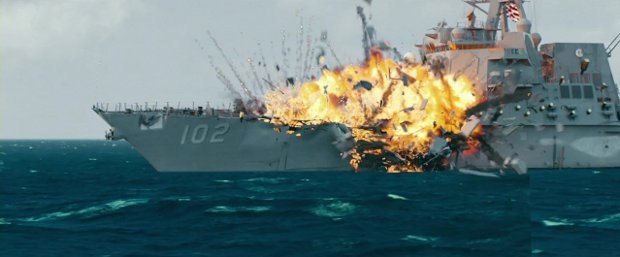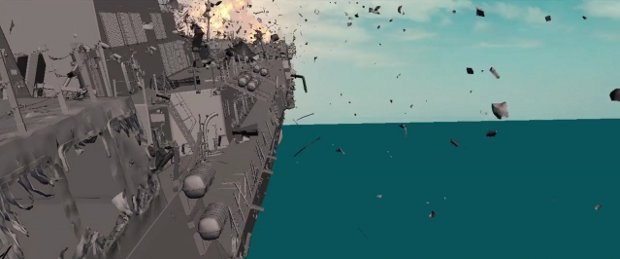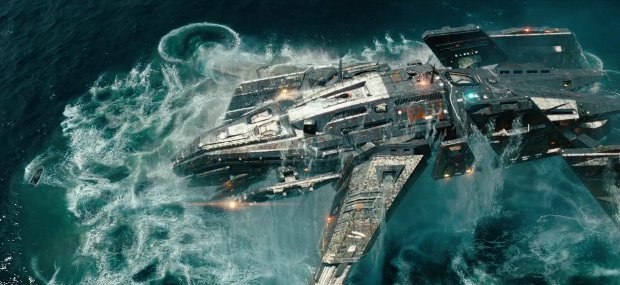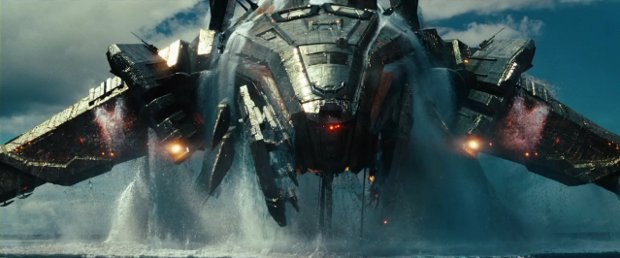Read about the latest advancements at ILM for Peter Berg's naval/sci-fi mash-up.
Battleship may have sunk at the box office, but Industrial Light & Magic has added some noteworthy wrinkles to its VFX arsenal that deserve attention. Scanline VFX and Image Engine upped their game as well.
Of course, what director Peter Berg wanted all along was to bring Battleship to the screen with an authentic real world sensibility for both the naval and alien ships. The mandate was to shoot at sea and to use real Navy ships, which played right into ILM's photorealistic ethos. They captured great footage and then recreated them in the computer for destruction.
However, the biggest challenge was the massively armored alien ships called Stingers, which are inspired by water bugs that can sit on top of the water and slide around the surface. In profile the Stingers have outstretched wings. Later on, though, Berg suggested that they could catapult into the air and then crash into the water. ILM VFX supervisor Grady Cofer and animation supervisor Glen McIntosh were initially terrified of that idea. "We did a test of the ship and that became an interesting characteristic, which led to some striking imagery," Cofer suggests. "In addition, they could recycle water. We dropped hoses underneath the ship that suck water and there are water ports around the outer surfaces. It became a personality shape, so if a ship got angry or was ready to attack, we could open up all of these water ports and jettison water out and leap into the air."
The aliens, Regents, took a year to develop. They have protective metal shields and helmets, which hide the humanoid creature inside. Berg wanted an alien that was more familiar and sympathetic, like old, grizzled, fighters from another planet. "So we created different personalities," Cofer continues. "He wanted some to be curious or over confidenct and in some cases scared. The Thugs are a subset that does all the dirty work. Unlike the more cerebral superiors, they're the infantry, so to speak, and are built to be tougher and stronger.
Veteran VFX supervisor Pablo Helman oversaw the creature work and says that the skin and lighting were the main challenges. In fact, ILM's skin texture was akin to a version 2.0. ILM also took advantage of its new facial capture system for close-ups (also utilized on the Hulk in Getting Animated Over The Avengers). ILM now acquires facial data on the mocap stage along with the rest of the performance using Imocap. "We developed a system by which every part of the face was captured," Helman explains. "Problematic areas around the mouth and eyes that had to be totally keyframed in the past are now captured on stage.
"There's also interaction between an actor's hand and the alien's eye. We had to replace everything that was touched, so all the shapes and the stretching of the skin needed to be spot on. All that was brand new technology. The actor's performance is key in this; unless you're rigging your face in a specific way you will not have made the choices related to the actual performance. The quick on set system and the coding is a 2.0 version of Imocap. The weight, timing and sequencing worked out well between the actor and stuntman."
Indeed, this is a backlit, grungy world, according to Helman. The camera swoops into the action. Helman also supervised the Shredders wheel weapon, launched from the alien ship, which attacks the Marine base. All the destruction is either elements or CG. The simulation engine is the same as the one used for the water.
And water was vital for Battleship. According to Cofer, the water breaks up into clusters and then droplets and finally droplets break up into mist. Over that lifespan, the water becomes more and more influenced by airfields and wind currents. This was a totally new type of physics and rendering of water for ILM, which worked out a pipeline and toolset with CG supervisor Willi Geiger.
"We wanted to be able to represent the physics of that, so it's a full cycle," Cofer suggests. "And our rendering techniques had to be upgraded as well. We wanted to render everything together as a volume so that when we're representing sunlight, say, that the sun is actually refracting through dense parts of water and then breaking up and illuminating in a scattered way."
This was essential for the alien Stingers, which rely heavily on detailed water interaction. Large scale water simulation is still based on a system of grids yet there is further optimization using a new solver for particle-based simulation. It is the meshing that allows the water to go through its full cycle.
Meanwhile, Scanline (under the supervision of Stephan Trojansky and Danielle Plantec) contributed to the Hong Kong destruction sequence, among others, making use of its acclaimed Flowline fluid simulation system, which created water trails and other activity.
Image Engine created the Thugs aboard the Naval Destroyer ship. ILM supplied the work-in-progress animated turntables and rig for Image Engine to take the Thug the rest of the way. "Initially the Thug was designed for a 'search and destroy' mission, which meant that it would smash apart the engine room to sabotage the ship," explains Image Engine's VFX supervisor Chris Harvey. "This mission changed part way through to reconnaissance, requiring a different approach to handling both the design and animation.
"The Thug was originally designed to look like an NFL Running Back, but Berg subsequently asked us to make him look like a big offensive Lineman," added animation lead Jeremy Stewart. "The new design brief was intended to make the Thug look bigger and heavily armored. The armor looks great, but unfortunately more armor usually means limited movement because in the real world, armor or even heavy clothing limits a person's mobility.
"We added a lot of controls to the armor which was rigged to the alien's skin, some to give us more movement, others to lock it place. During animation, we put a lot of consideration into how the body movements would affect the armor. Although we had motion capture for most of the shots, we had to thoroughly edit it and often completely replace it to keep the armor looking intact. The mocap was also revised to give a better sense of weight and timing."
--
Bill Desowitz is former senior editor of AWN and VFXWorld. He's the owner of the Immersed in Movies blog (www.billdesowitz.com), a regular contributor to Thompson on Hollywood at Indiewire and author of James Bond Unmasked (www.jamesbondunmasked.com), which chronicles the 50-year evolution of 007 on screen and features interviews with all six actors.























